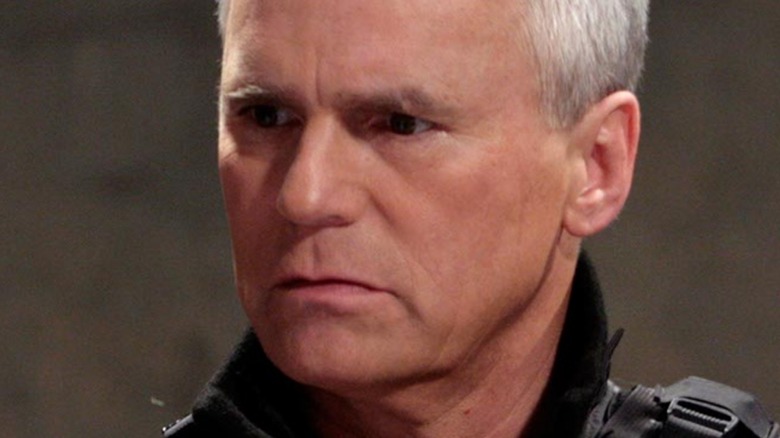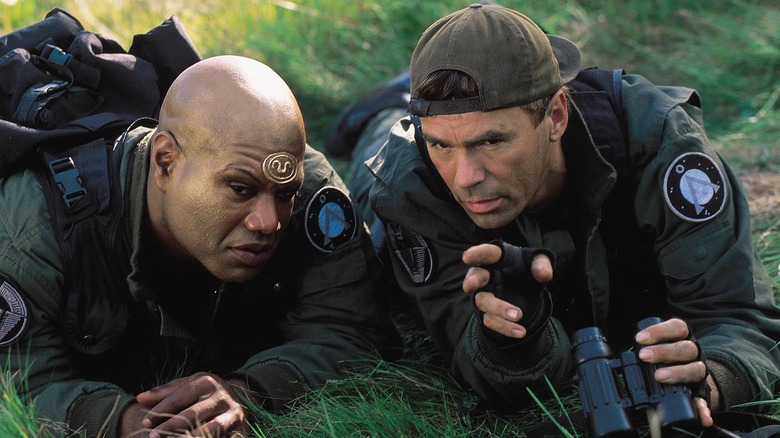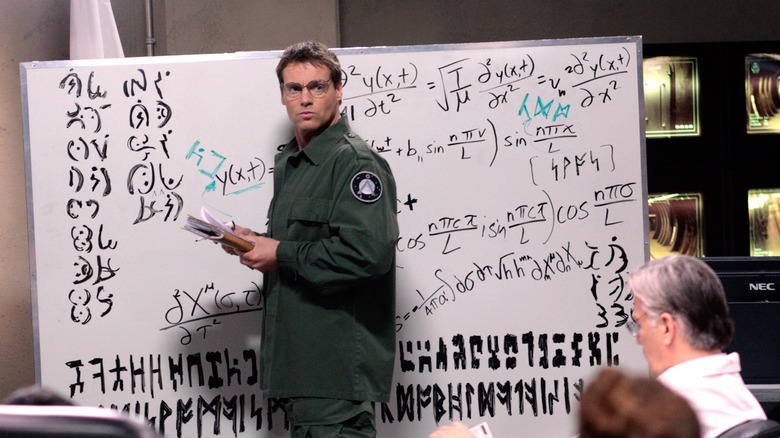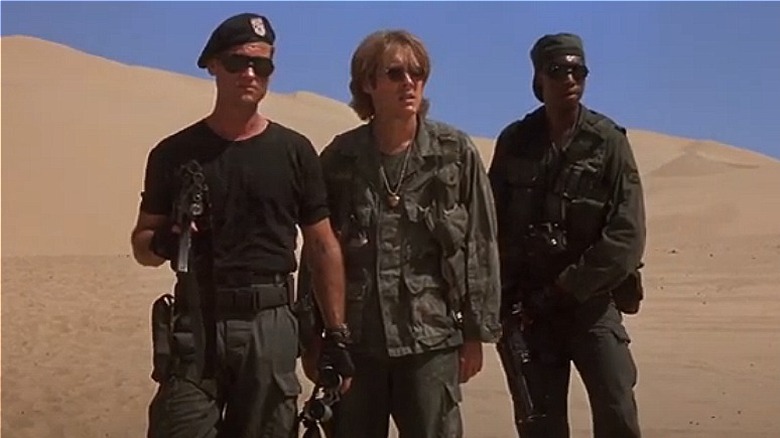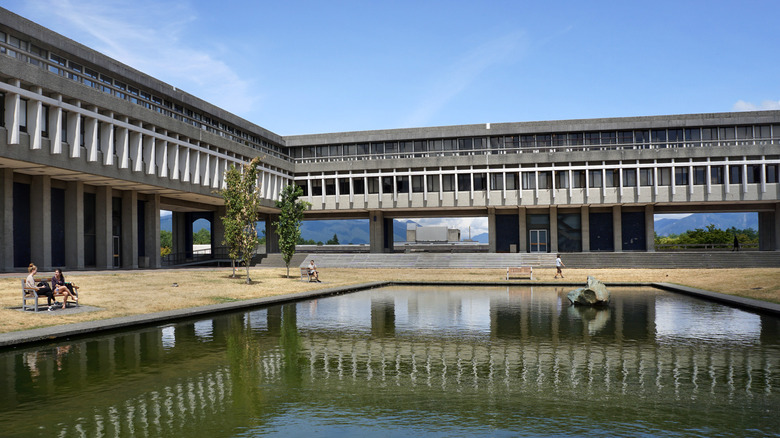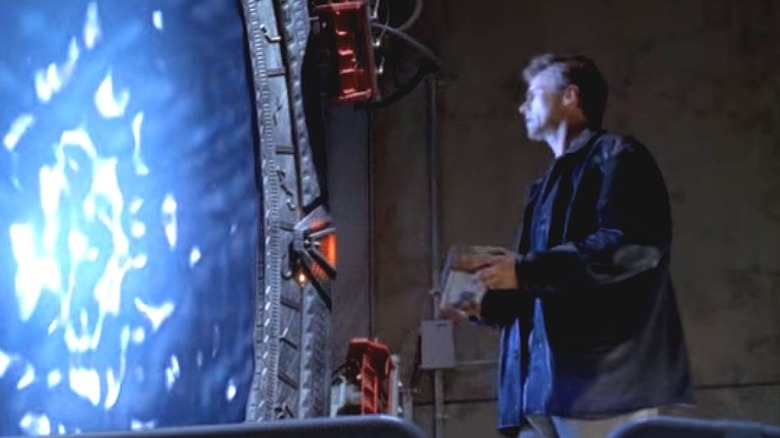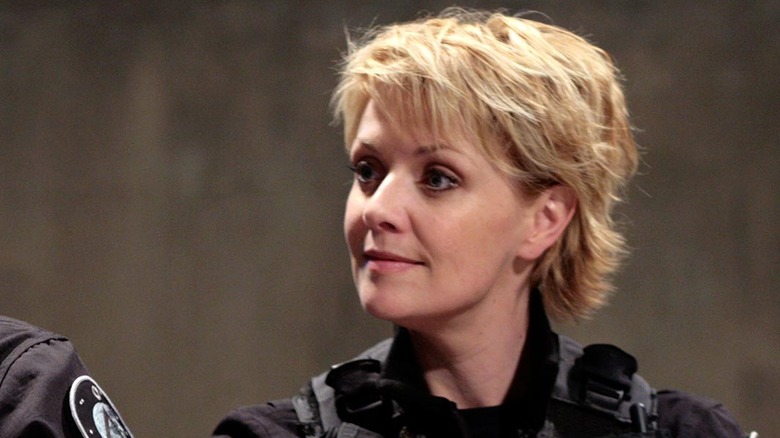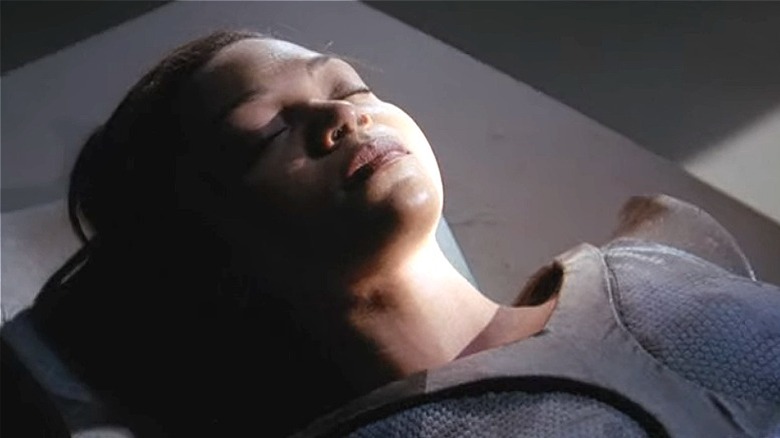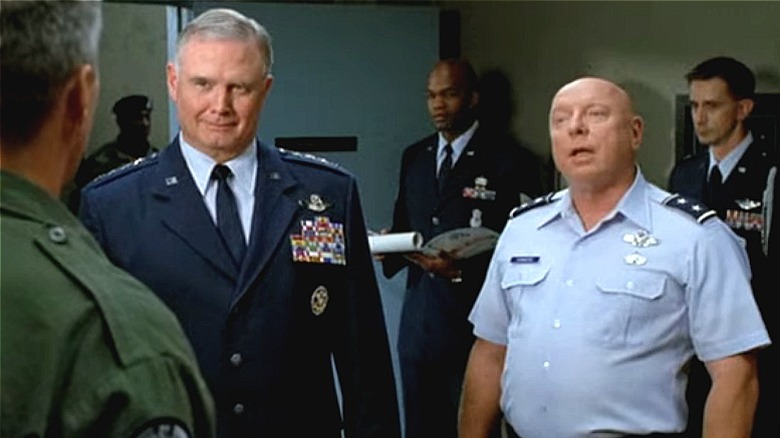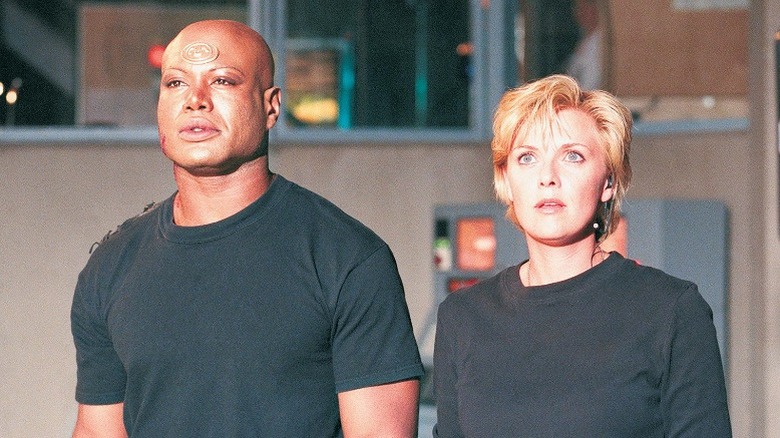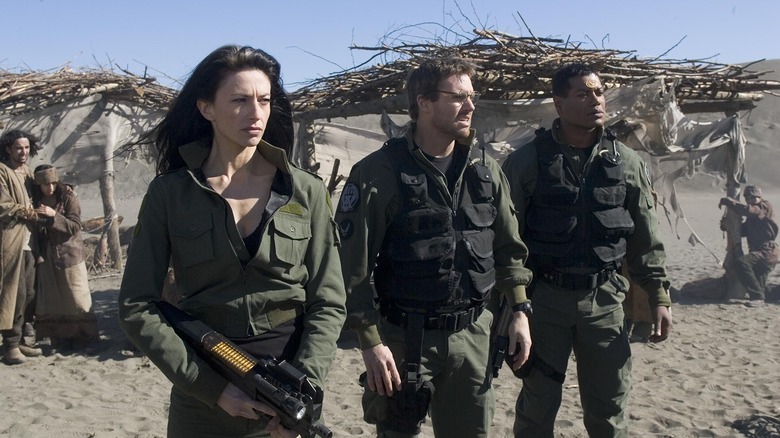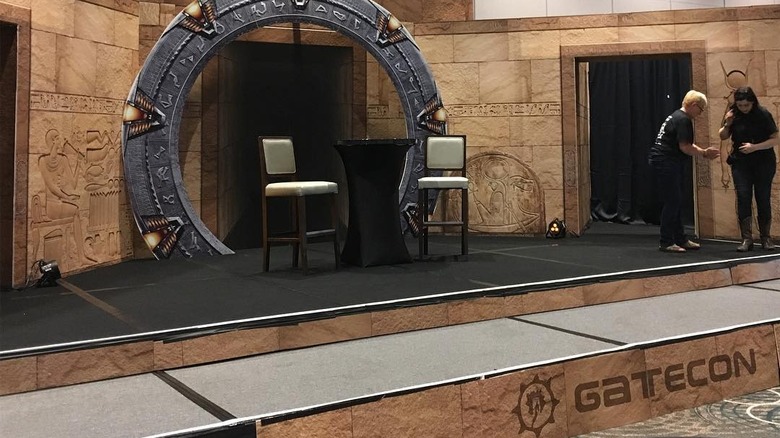The Untold Truth Of Stargate SG-1
We may receive a commission on purchases made from links.
"Stargate SG-1" first premiered in 1997 on the Showtime network. As a follow up to the 1994 film, "Stargate," it was one of a handful of properties that started as a live-action film and continued as a live-action show. Though a new show is always a risk, "Stargate SG-1" lasted ten seasons for a total of 213 episodes as well as two straight to DVD films.
Starring Amanda Tapping as Major Samantha Carter, Christopher Judge as Teal'c, Michael Shanks as Dr. Daniel Jackson, and Richard Dean Anderson as Colonel Jack O'Neill, the series primarily follows these characters as they use an ancient alien device known as a stargate to travel to different planets. During these travels, the team encounters aliens, connects with distant human populations, and combats the parasitic Goa'uld as well as other extraterrestrial threats.
With 2022 marking the 25th anniversary of the show's debut, it is an excellent opportunity to explore aspects of this series that even hardcore fans may not know.
A show instead of a cinematic sequel?
1994's "Stargate" was not a critical darling — Rotten Tomatoes' analysis of critical reviews about the film gives it a 53% rating. However, it was an incredibly successful film commercially. At the time, "Stargate" was also the largest October opening film, and with a production budget of $55 million, the movie profited nicely from its $195 million haul at the box office.
This kind of success typically leads to the development and release of a cinematic sequel, but that didn't happen. Instead, Stargate — as a franchise — would morph from film to television. Years after "Stargate" was released, Dean Devlin (a co-writer and co-producer of the film) was interviewed about his original plans for the franchise. In the process, he talked about how MGM went from distributing the film to owning its rights.
"The film was made entirely independently, there was no studio involved," Devlin told GateWorld. "MGM agreed to release the film when no one else would release it, because no one believed in the movie. And the week before the movie opened, the people who had financed the movie, which was a group out of France, they were so sure that they had a bomb, they sold the movie to MGM for $5 million. So then, MGM owned the movie."
For reasons unbeknownst to Devlin, MGM not only decided to bring the franchise to television, but it also decided to change the creative team.
Stargate's creative was not involved with Stargate SG-1
After the movie had run its course and with the property fully owned by MGM, Devlin and co-writer and director Roland Emmerich approached MGM about creating more "Stargate" properties. Knowing that MGM wanted to do a television series instead of a sequel film, Devlin and Emmerich met with MGM to pitch ideas, only to be told by MGM that "we don't really want you guys involved," as Devlin recalled to GateWorld.
Instead of Devlin and Emmerich, MGM selected Brad Wright and Jonathan Glassner to head the "Stargate" TV series.
This rejection led to Devlin being angry. He described it to GateWorld as "somebody else raising your children." In time though, he realized that the people behind the TV show "must have been doing something right," because of how popular the series had become. This continued popularity of the franchise he started motivated Devlin to reach out to Glassner. The two got along so well that the "Stargate" vets decided to work on the television show "The Outpost" together.
Switching a creative team so early on in a franchise's life is a risky move, and MGM is lucky it paid off. In retrospect, it is possible that MGM realized that in order for "Stargate" to evolve, it would need a team willing to make changes the original creators would not.
Stargate SG-1 deviated from Stargate from the start
In order to turn "Stargate" from a movie franchise into a television series, Brad Wright and Jonathan Glassner realized changes had to be made. The most notable of which were among the cast, including co-leads James Spader and Kurt Russell (above). While it's unclear exactly why neither returned for "SG-1," both actors had been critical of the "Stargate" script (although Spader later spoke with reverence of the finished product.)
Speculation about Russell and Spader's motivations aside, the creative team recast main characters Jack O'Neil and Daniel Jackson with Richard Dean Anderson and Michael Shanks, respectively. Glassner and Wright also knew that elements of the movie would have to be retconned in order for a weekly series to work. For instance, Glassner has said in interviews that O'Neil had to change from being suicidal in the film to having a sense of humor in the show. Additionally, Ra (the evil alien from the film) went from being the last of his kind, to being the supreme leader of a system lords called the Goa'uld; a race of parasitic aliens that enslaved human populations.
The biggest change were the stargates being altered from just two devices to a network of rings scattered across the galaxy. With thousands of planets that could be visited, Stargate grew into a franchise that spanned a universe.
Vancouver is at the heart of Stargate SG-1
While it has become commonplace for shows and movies to be made in Canada, "Stargate SG-1" embraced Vancouver and British Columbia in a way few shows have done. Dozens of locations in the show were actually in the Vancouver area, including the Season 6 episode "Nightwalkers," which saw Steveston, British Columbia stand in for Steveston, Oregon. Another memorable Vancouver site in the series comes when Simon Fraser University is transformed into the Tollan home world.
But the Vancouver landscape, at times, proved to be a challenge when it needed to portray varied alien worlds. "We really started struggling to create locations that were not just in the forest," visual effects supervisor John Gajdecki said in an interview for The Companion app (via GateWorld). But the production team got creative, even using sulfur pits located near the Vancouver docks to emulate "the yellow dunes of P3X-562."
With that said, "Stargate SG-1" didn't just borrow from Vancouver, it substantially contributed to the community in which it was produced. In a 2006 article for The Vancouver Sun, titled "Stargate's success is out of this world," it is revealed that the Stargate franchise brought in over $500 million in production to the area. At the time, that would encompass all ten seasons of "Stargate SG-1" and three seasons of "Stargate Atlantis." For context, spending on film and television production in British Columbia during 2006 was valued at $1.228 billion.
Stargate SG-1 set records
There are many ways to determine if a show was successful or not. One way to see how many records a series set, and "Stargate SG-1" set several records.
Right out of the gate, the show's pilot set a landmark for Showtime. As Ray Richmond wrote for Variety, "Sunday's two-hour premiere episode of the MGM Worldwide TV Group series "Stargate SG-1" generated for Showtime's highest-ever ratings for a series premiere." According to data gathered by Nielsen, the pilot "tallied a healthy 10.5 rating in Showtime's approximately 12 million U.S. households, or just shy of 1.5 million homes in total."
The anticipated success for the show motivated Showtime to order 44 episodes before "Stargate SG-1" even debuted in 1997. In short order, the network ordered another 44 shows, followed by "the syndicated deal with the Sci-Fi Channel," that brought the network's commitment to the show "up to six years," as Richard Dean Anderson told Parade Magazine at the time, in 1998. This kind of commitment is extremely rare for hour-long science fiction shows. Also, an often overlooked element of "Stargate SG-1" moving from Showtime to the Sci-Fi Channel (now known as Syfy) was that it was part of a then historic $150 million deal in which Sci-Fi got "Stargate SG-1" along with "The Outer Limits" and "Poltergeist: The Legacy."
Showtime wanted Stargate SG-1 to be sexy
"Stargate" had a PG rating, but Showtime initially pushed for "Stargate SG-1" to have sexual content. The first version of the pilot, titled "Children of the Gods," showed Vaitiare Bandera (in the role of Sha're) topless. The inclusion of nudity gave the episode a rating of M, for mature.
Reflecting on the topless scene in an interview, Jonathan Glassner talked about how he didn't want it. "We were kind of unhappy with it having nudity in it, but the studio thought that it would help the ratings on Showtime," Glassner explained to GateWorld, adding, "Because Showtime, at that time, was the only thing they were known for. I remember they had full nudity."
The nude scene was cut from a later version of the episode, however, this wasn't the only example of over sexualization the network wanted. When recalling the initial look Showtime wanted for Samantha Carter, Amanda Topping discussed how upsetting her first wardrobe options were.
"I was asked to put on a push up bra and a tiny little tank top as my very first wardrobe fitting and I panicked because I thought oh my god, they cast the wrong person,'" Tapping told Moviehole in 2009. "I'm not that and this character isn't that, and if they wanted a blonde boobie bombshell they cast the wrong girl. I remember crying in Christina McQuarrie's little wardrobe change room and saying why are they asking for this?"
Luckily, Tapping successfully pushed against this, with showrunners Jonathan Glassner and Brad Wright supporting her protest.
Stargate SG-1 was filming during 9/11
The 9/11 terrorist attack deeply influenced which movies and shows would be produced for years. Though 9/11 wasn't directly referenced in "Stargate SG-1," the event still affected the show.
The attack happened when the show was in production on the Season 5 episode "Menace." In the opening scene of the episode, SG-1 enters a building in which the android Reese is located (above). This was thoroughly discussed in the director's commentary for the episode in the Season 5 DVD collection. According to episode director Martin Wood, "The first tower had just been hit when we were shooting [the scene in which Reese is found on a table]."
News of the terrorist attacks caused Christopher Judge (Teal'c) to ask that he be moved to the background instead of in the forefront. Due to having family in New York at the time, Judge was emotionally distraught. While the actors were still expected to do their jobs, Wood remembers on that day that "what these actors are thinking about right now, unfortunately, is September 11th and the tragedy that was unfolding."
The U.S. military became an integral part of Stargate SG-1
The United States military has worked with entertainment companies for decades. Branches of the military, the Department of Defense, the Pentagon, and other organizations not only regularly consulted on shows and movies to make sure service members are depicted accurately, they have even helped produce some content. For example, "the U.S. Navy had a hand in producing" the 2012 film, "Battleship," according to Movieline.
With "Stargate SG-1" featuring many military characters, it is not surprising that the Air Force worked closely with the show's production team. On the show "Today's Air Force," showrunner Brad Wright shared that "Stargate's relationship with the Air Force really began in Season 1, during the filming of the pilot." From then, the Air Force not only read scripts "for authenticity" but sent an Air Force captain who offered on-set technical advice. This relationship became so strong, that by Season 4, real elements of the Air Force were incorporated into the show. This led to C-130s and F-15s being featured in the show alongside real-life leaders.
For instance, General Michael E. Ryan (above left) appeared as himself in Season 4's "Prodigy," followed by General John P. Jumper, who appeared in Season 7's "Lost City, Part 2." Both of these men were not only generals, but they served as chief of staff for the Air Force during their careers. The presence of two real generals in "Stargate SG-1" is a massive seal of approval that few entertainment franchises will ever achieve.
Guinness World Records honored Stargate SG-1
Historically, the goal of any TV show is to hit syndication. That means re-runs played on a network other than the one that originally aired the show. It also means big money. As TV by the Numbers explained in 2011, in order for a network to "command higher per-episode pricing" for a syndication deal, "the magic number ... used to be '100' but at least for the last few years it has been 88."
Given that television shows can lose audiences rather quickly (or not get them at all), it is statistically unlikely for a show to hit the 88 to 100 episode mark. However, "Stargate SG-1" not only went long enough to hit 100 episodes, it went on long enough to set a Guinness record.
In 2006, it was announced that "Stargate SG-1" earned the title of the Longest Consecutive Running Sci-Fi TV Show. As GateWorld reported, "'Stargate SG-1' has run without a break for nearly 10 years, since its first episode, 'Children of the Gods,' premiered on July 27, 1997. As of the 203rd episode, "Company of Thieves," SG-1 will beat the 202 episodes of 'The X-Files,' which ran from September 10, 1993 through May 9, 2002."
This record was broken by "Smallville" in 2010, and again by "Supernatural," which ran for 15 seasons (a length encompassing 327 episodes).
Stargate SG-1 feared cancellation many times
Even successful shows fear cancellation. Sometimes, a popular show ends if the production costs become too much or if the network thinks it can replace it with better performing programming. This was the case for "Last Man Standing" when it was first canceled by ABC. "Stargate SG-1" was in a similar situation. Though incredibly popular, its production team spent many years not knowing if it would be renewed.
David Howe, a former executive VP and general manager for the Sci Fi Channel, shared this insight in a 2006 article from The Hollywood Reporter. "I've been here for five years, and almost every year we've had the debate, 'Is this the last year?'" Howe said when reflecting on if "Stargate SG-1" would get canceled or not. "And every year, we say 'No, one more season, but next year is definitely the last.' We thought we'd pass the baton to 'Atlantis,' but all we've done is double money and our audience.'"
This indecisiveness impacted how the show's creative team operated. Speaking with GateWorld, writer and executive producer Joseph Mallozzi shared how "every season we approached the finale as though it would be a series finale."
The passionate and philanthropic fandom of SG-1
In general, science fiction and fantasies generate passionate fandoms. The desire people have for escapism is a powerful motivation. As a result, the relationship between a show and its fans has always been tense. However, "Stargate SG-1" is one of the few shows that understood its fanbase early on and decided to work with fans. (Professor Henry Jenkins has even highlighted how passionate Stargate fans are.)
Gatecon is a regular celebration of the "Stargate" franchise that was first held September 22, 2000. This event was not only created by fans, but created by those who began initially networking on a fan site called Stargate SG-1 Dot Com. Their goal at the time? "All they really wanted was a Stargate T-Shirt," Gatecon cheekily states. From there, the show's superfans "began talking about conventions, and how good it would be to do a Stargate fan convention."
In addition to the events being a place for the creators and actors to meet fans, it also regularly raises money for charity: "more than $250,000 for [Make-a-Wish British Columbia & Yukon] since 2000," according to Gatecon.
Of all the other examples of how passionate "Stargate" fans are, the most recent example came in August 2021, in which the fan organization Stargate Now Europe launched 365 Days of Stargate. With news that Stargate's parent company, MGM, might be purchased by Amazon, fans have committed to posing #WeWantStargate in the hopes that Amazon will bring the franchise back.
